How To Sell Strat-O-Matic Baseball Products
A basic guide for flippers, returning players, and others
How To Sell Strat-O-Matic Baseball Products
I came across this auction listing yesterday:
Fortunately, the seller decided to end the listing early after realizing the error of their ways.
A glance at the photos revealed that none of the three games contained any actual player cards. Some things were in an absolutely chaotic state, too:
It’s pretty clear that the seller is a flipper who happened to purchase these sets somewhere or other. It might have been at an estate sale, a thrift store, or it could have even been a hand-me-down from a deceased relative.
After reading this, and after some interactions with others who don’t know what they have, I thought it might be helpful to write a guide to the art of selling Strat-O-Matic baseball products. Note that I’m only going to focus on the baseball products and not on any of the other sports.
Who Buys This Stuff?
The most important thing to figure out is your target audience.
In my experience, most people who purchase Strat-O-Matic stuff want to play with the cards. Some are motivated by nostalgia; others really want to conduct a replay of a specific season that may be out of print.
I’m not aware of a large market dedicated to collecting alone, by the way. While some of the rarer years are obviously collectable, Strat cards really don’t receive much attention from mainstream baseball card collectors. In fact, a lot of the confusion you see around card and game prices comes from how niche these products are.
Because most people who buy this stuff want to actually play with it, it’s important that games you sell contain player cards if possible. There’s no way in the world a Strat player will pay $225 for old football, basketball, and hockey games without any cards — especially since you can buy all three games brand new from the company for less.
That’s not to say that games without cards don’t sell. They do sell, especially if they are older games that are clean and that have been well taken care of. Remember, however, that the reason people buy this stuff is usually to play with it — not to look at it.
In general, baseball seasons not currently sold by the game company will command higher secondary market prices than seasons currently in stock. However, original copies of seasons will usually command a higher price than reissued versions, even though the newer versions might have additional features and more cards.
For example: Strat-O-Matic recently created an updated version of the 1980 season. It retails at $63 brand new:
Don’t let the fact that the 1980 season is currently in stock cause you to think that the original version is worthless! 1980 Strat seasons routinely command more than $63 on the secondary market, and can attract particularly high bids depending on a few condition and completeness factors.
Also, keep in mind that not all Strat-O-Matic current releases are printed to demand. Strat-O-Matic’s reprint of the 1975 season sold out years ago, for example. That season is currently out of stock. As a result, the secondary market price of the reissued season sometimes comes very close to the price of the original:
If Strat were to rerelease the 1975 season (and I think that might happen in the next few years), you’d see the earlier rerelease fall in price. This is because those hoping to play a 1975 Strat-O-Matic replay would have an alternative product to choose from. The original, meanwhile, would likely retain its value.
Condition
Since the very beginning, Strat-O-Matic included rubber bands with its cards. Most players would group teams together and stick a rubber band around them. If that rubber band remained on the cards for years, the cards would likely become stained. Older cards with staining issues like this are pretty common:
Note that you can still read Sambito’s basic game results through the stains. As long as the card is still legible and usable, there will be demand for it. However, keep in mind that unstained cards will fetch a premium.
Sometimes you run into coffee and food stains as well:
Again, this isn’t necessarily a deal breaker. However, if you’re buying cards like this, make sure that you don’t pay the rate that clean copies of the same set are going for.
To maintain the condition of Strat cards, I strongly recommend removing old rubber bands and using a different storage method. Some people use plastic bags for teams:
However, I recommend using individual sleeves for each card. You can find them for cheap through clearbags.com, and they fit so snugly that the company actively advertises their use with Strat-O-Matic:
It takes time to sleeve cards individually, but it’s worth it. I’ve noticed that players tend to pay a bit more for cards that have already been sleeved even if they have existing stains.
Additional Players
Since 1962, Strat-O-Matic sets have consisted of 20 players per team. Sometime around 1968, Strat started offering separate sets of additional players. These usually consist of 4 or 5 additional players per team.
If the additional players are included, the set will be worth more to collectors. This isn’t necessarily because the additional players are extremely rare. Rather, this is because of how much easier it is to complete a replay project when you’ve got the extra players.
The only surefire way to tell if you’ve got the extra players or not is to look at the roster sheet. Fortunately, Strat-O-Matic maintains a roster sheet archive for free. This is very helpful if the original roster sheet was lost or misplaced over the years.
Here’s what the original 1980 National League roster sheet looks like:
The list of players by position refers to the base set. The additional players are listed under the “50 ADDITIONAL PLAYERS - NATIONAL LEAGUE” heading. Also, pay special attention to the four players whose cards do not contain a team name.
You can save yourself a lot of headache and returns if you take the time to verify that all cards are present and accounted for. Additionally, those extra players (108 total for 1980) can significantly increase the interest in your auction if you can confirm that they are included.
Note that reprinted seasons and other past seasons do not have optional additional players. The recently reprinted 1980 National League roster sheet looks like this:
Though the newer set has more players and more playing options, the older set still tends to command a higher price — especially if the extra players are included.
Special Stuff
There are a number of special variations to keep in mind.
The original 1975 season, for example, comes in two variants: a normal version and a glossy version. The glossy version features a glossy finish on the basic game side of each card (including the additional cards), and tends to attract a slight premium.
The advanced side of pitcher cards in the original 1980 season were not correctly randomized, leading to a massive uproar in the community. The cards are accurate, but they follow a specific, predictable pattern. Strat-O-Matic offered replacement cards for a brief period of time. Those cards are single sided — advanced side only — and contain essentially the same results as the original issue, though randomized so that not all hits appear in the same column. That specialty additional pitcher set is rare — and can significantly enhance the value of an original 1980 set if you happen to own it.
Other specialty Strat sets, such as the special cards printed in Strat Fan in the 1990s, also have some value. The Strat Fan cards tend to have the highest value if they are unpunched and still in the original magazine.
I’ll write further articles on these variations in the future.
What Doesn’t Matter
I’m not aware of any major Strat-O-Matic counterfeiting programs or rings. As a result, there isn’t really much demand for cards that have been professionally graded. Most buyers actually want to play with the cards, and likely won’t be happy with cards surrounded by plastic slabs.
Starting with the 1987 season, Strat-O-Matic baseball cards came on perforated sheets. Before that season, cards were individually cut by the company. As a result, older cards tend to be off center — sometimes radically so. Centering issues generally don’t impact the secondary market value of cards so long as they are still legible.
While including a complete game with the original card set is a nice touch, it doesn’t necessarily enhance the value of the package. There is an exception for original games that have been well cared for, however — and I also generally believe that you should keep a game and its cards together if they were originally purchased that way.
While there is a market for individual teams not part of complete seasons, those teams don’t tend to attract particularly high prices. For years Strat offered new customers the ability to buy the game with a selection of teams at a lower price. I believe the game was sold in toy and hobby stores for years with 4 or so regionally appropriate teams. As a result, you’ll find a lot of eBay auctions for complete games that include something like 4 teams from 1971 or 4 teams from 1978 or something like that. Because the people who chiefly buy these sets are interested in replays, incomplete seasons will attract far lower prices.
There are quite a few variations of the Strat-O-Matic box. With the exception of the original box, however, the variations don’t really command any special secondary market price. Remember, too, that Strat reprinted its original box and cards about a decade ago in a limited set. If you’re buying really old Strat cards for a really high price, make sure you’re not getting a reprinted version.
Hopefully this is at least somewhat helpful. Whatever you do, don’t fall into the trap of buying an old Strat game with no player cards for hundreds of dollars.





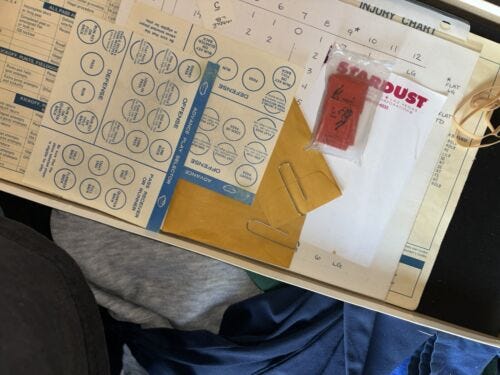

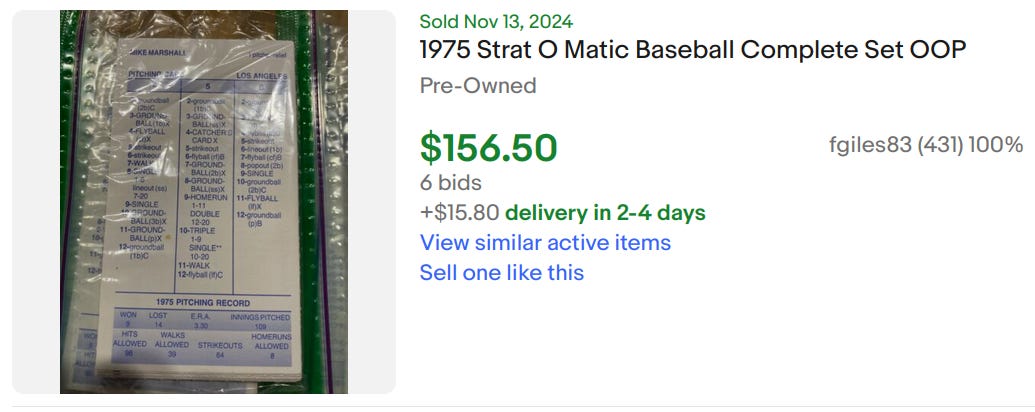
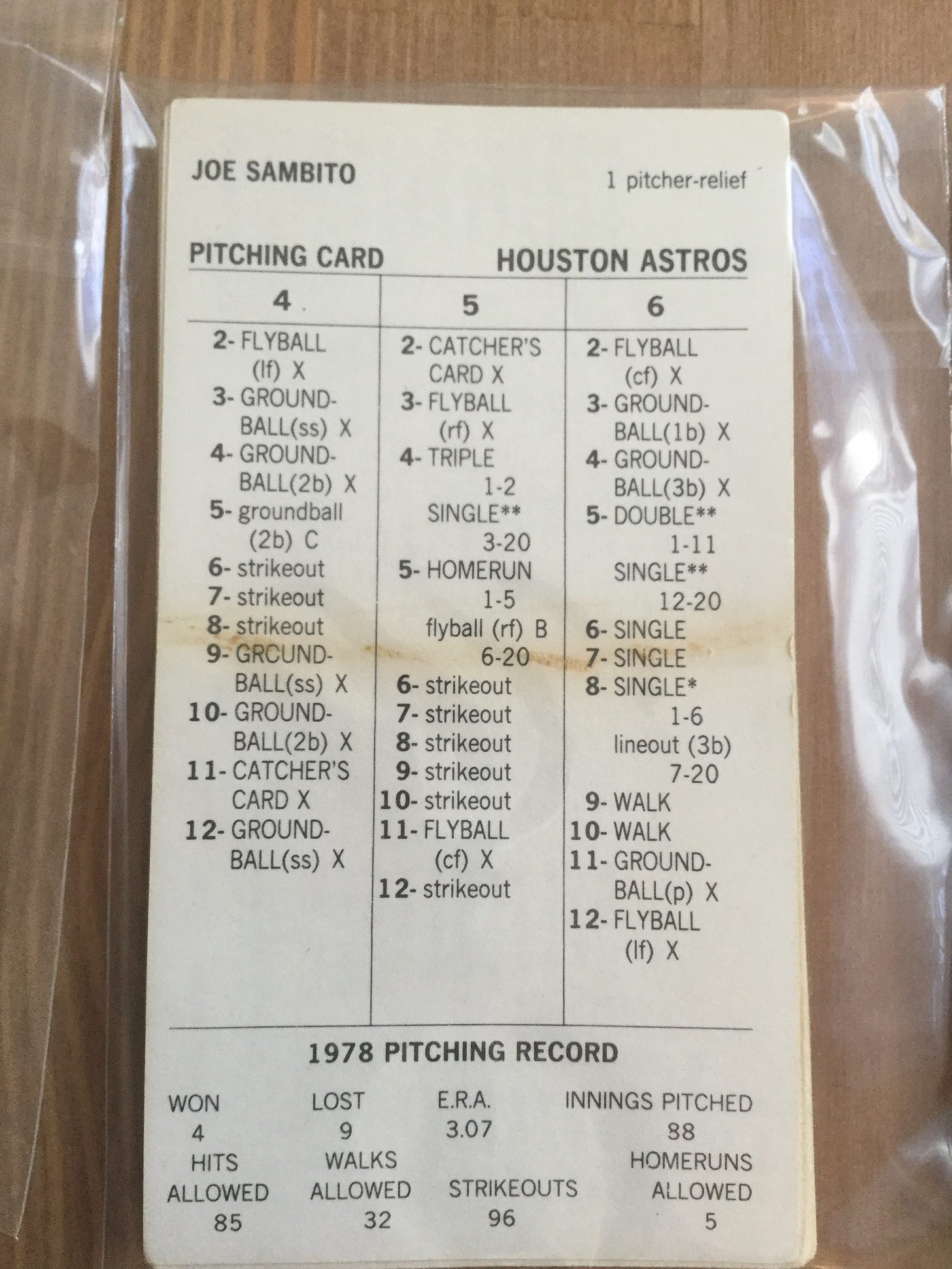
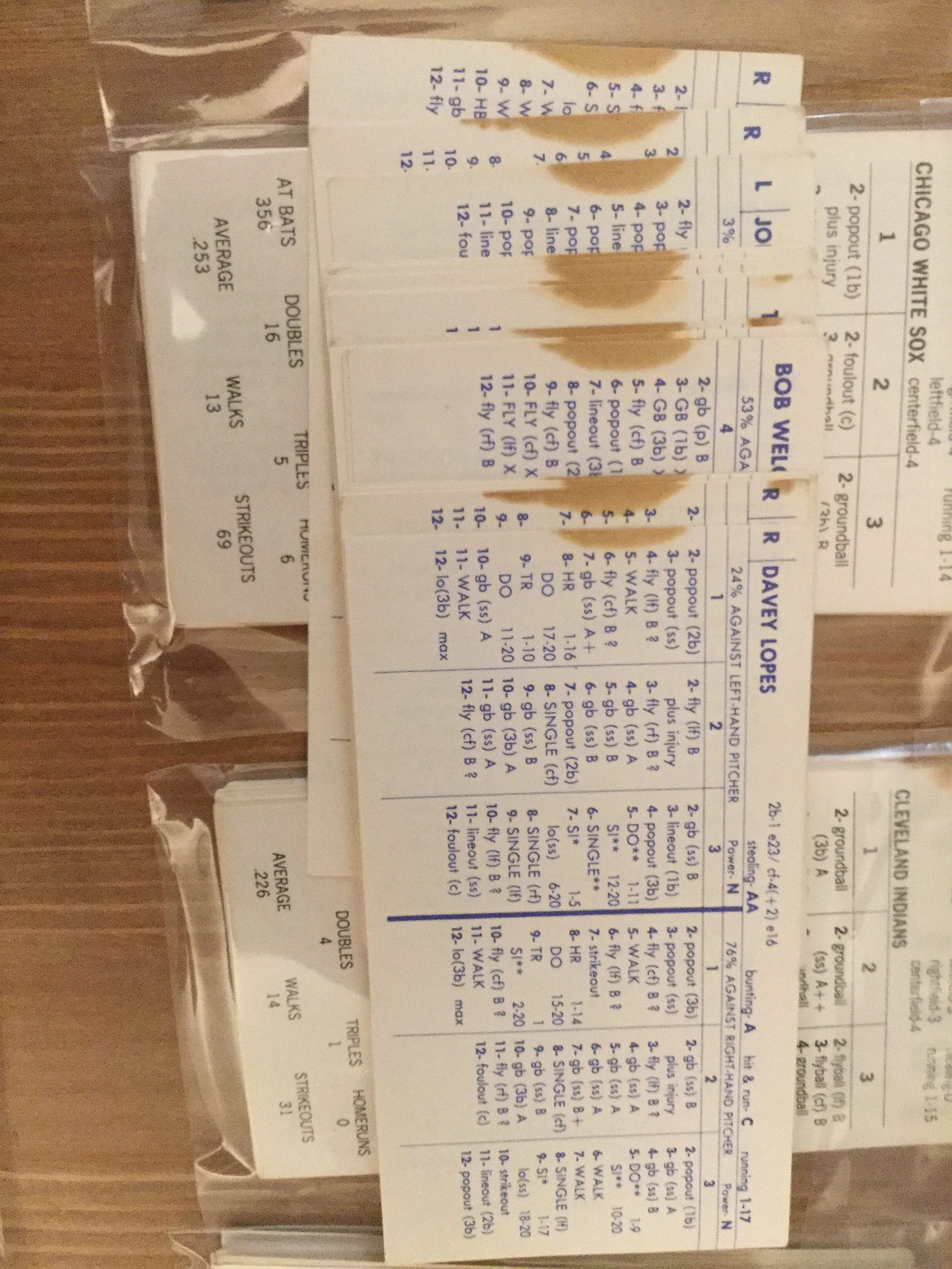




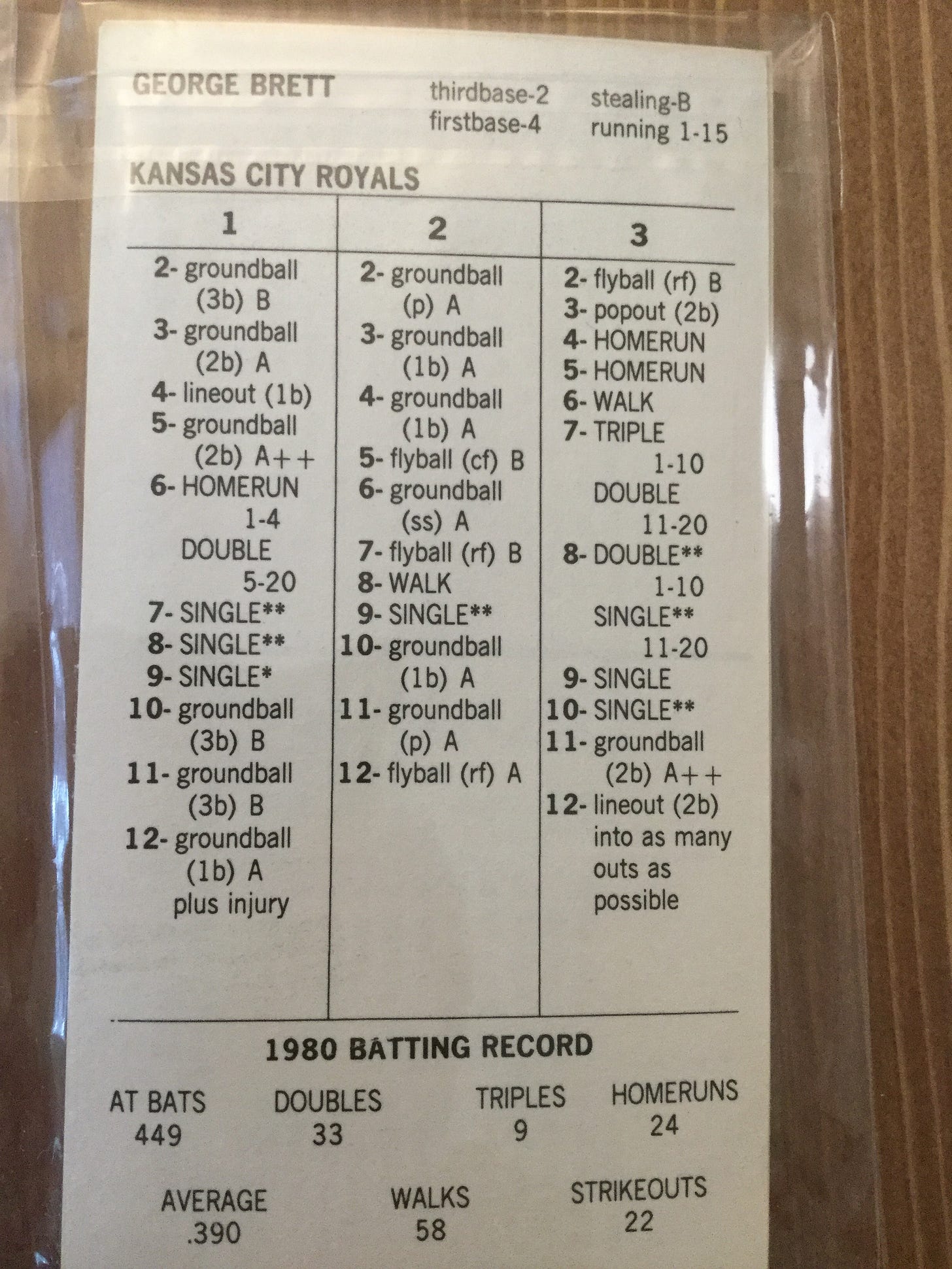
Another thing. Old Strat sets can always be found for reasonable prices, but people have to look around and be patient (eBay, Facebook, Delphi, goodwill, etc.) In the last few years, I've bought dozens of oop sets for $75 and below. I've since stopped chasing the rush of acquiring stuff, and only have a few sets to roll. I'm passionate about this because like anything, there are rip off artist selling sets for hundreds.
Strat was marketed in the early days as a collector item. You can read it on the live action box. This was clever, sets would go out of print, and still do for that matter, and become pricey. This led many people to buy multiple sets upon release, and they'd sell the extras for profit when the sets went oop. This also benefited the company since they had limited space, and it led to greater sales upon release.